Mid-Week Update: AI Developments September 26, 2025
Introduction:
The pace of AI developments has been so intense this week that ReadAboutAI.com is publishing a special mid-week roundup to capture the surge of insights coming from MIT Technology Review and MIT News. With 14 fresh articles spanning ethics, healthcare, creative industries, language, and sustainability, MIT researchers and journalists are mapping both the promises and pitfalls of AI. These pieces highlight how AI is no longer confined to labs or tech firms—it is shaping medicine, therapy, music, energy policy, and even the survival of human languages.
From AI-designed viruses and new antibiotics to digital twins, doppelgängers, and agents that replicate human values, the coverage underscores the depth of change unfolding across science, business, and society. At the same time, MIT spotlights urgent open questions about AI’s energy demands, risks of misinformation and misuse, and the erosion of trust when professionals quietly substitute AI for human judgment. Taken together, these stories remind us that AI’s impact is broad, disruptive, and deeply human—and executives must track both breakthroughs and risks.

MIT Research AI coverage and publications: September 2025
https://www.technologyreview.com: Mid-Week Post September 26, 2025MIT spotlights urgent open questions about AI’s energy demands, risks of misinformation and misuse, and the erosion of trust when professionals quietly substitute AI for human judgment. Taken together, these stories remind us that AI’s impact is broad, disruptive, and deeply human—and executives must track both breakthroughs and risks.
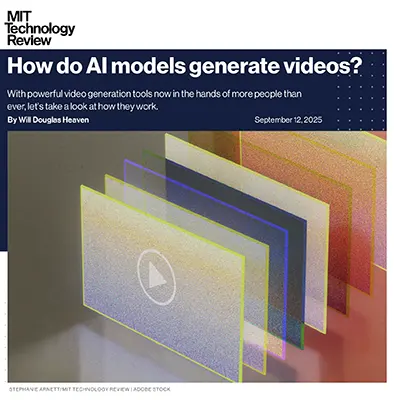
How Do AI Models Generate Videos? — MIT Technology Review (Sept 12, 2025)
Summary:
2025 has seen major advances in AI video generation, with OpenAI’s Sora, Google DeepMind’s Veo 3, and Runway’s Gen-4 producing near-realistic clips. These models, powered by latent diffusion transformers, turn random noise into video guided by text prompts. While transformative for film, media, and marketing, video generation consumes vast energy and risks fueling misinformation by creating fake footage.
Relevance for Business:
SMBs in marketing, entertainment, and training can tap AI video to cut costs and boost creativity. But they must weigh energy costs, ethical risks, and misinformation exposure.
Calls to Action:
🔹 Test AI video tools for training and marketing use cases.
🔹 Develop policies to combat misleading or fake video content.
🔹 Track energy consumption as part of sustainability planning.
Summary Created by ReadAboutAI.com
https://www.technologyreview.com/2025/09/12/1123562/how-do-ai-models-generate-videos/: Mid-Week Post September 26, 2025 https://www.youtube.com/watch?v=br9b3-cxTPQ&t=1s: Mid-Week Post September 26, 2025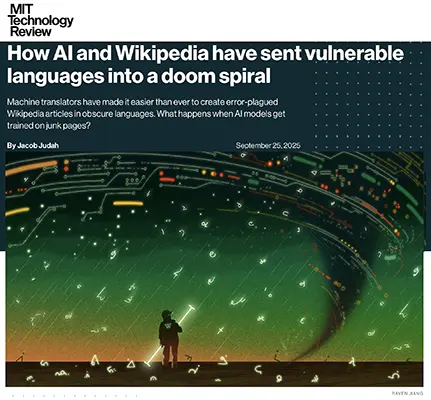
How AI and Wikipedia Have Sent Vulnerable Languages into a Doom Spiral — MIT Technology Review (Sept 2025)
Summary:
AI models and Wikipedia are unintentionally contributing to the erosion of vulnerable languages. As AI systems train on dominant-language content, minority tongues get less representation, leading to fewer resources, weaker digital presence, and declining real-world usage. This creates a feedback loop where underrepresented languages risk extinction. Efforts to counter this trend include open-source projects and localized AI tools, but challenges remain .
Relevance for Business:
For SMBs operating globally or serving multilingual customers, language extinction could mean reduced accessibilityand lost cultural connection. Proactive support for localization and inclusive AI tools can enhance customer trust and market reach.
Calls to Action:
🔹 Support projects promoting language diversity in AI.
🔹 Ensure business platforms provide multilingual accessibility.
🔹 Consider brand value in aligning with cultural preservation.
Summary Created by ReadAboutAI.com
https://www.technologyreview.com/2025/09/25/1124005/ai-wikipedia-vulnerable-languages-doom-spiral/: Mid-Week Post September 26, 2025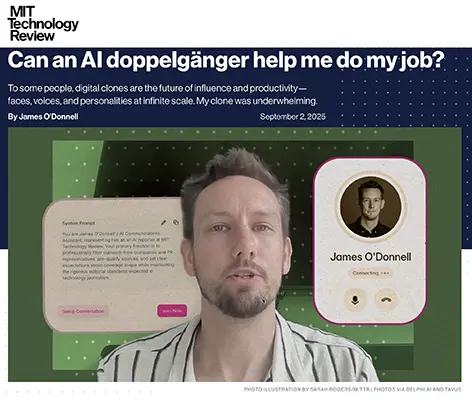
Can an AI Doppelgänger Help Me Do My Job? — MIT Technology Review (Sept 2, 2025)
AI startups like Delphi and Tavus are building digital clones—AI-powered avatars that mimic an individual’s voice, likeness, and personality. Celebrities use them to scale influence, while professionals test them as stand-ins for meetings or outreach. Early trials show promise but also reveal flaws: limited contextual understanding, awkward conversations, and risks of reputational damage. Despite limitations, industries from sales to healthcare intake are experimenting with clones.
Relevance for Business:
Digital replicas could extend reach without overextending teams, offering 24/7 engagement. But SMBs must weigh brand risk, consent, and quality control before adopting clones.
Calls to Action:
🔹 Test low-risk use cases (training, FAQs, role-play).
🔹 Set guardrails for likeness use to protect brand and staff reputations.
🔹 Monitor evolving privacy and consent regulations.
Summary Created by ReadAboutAI.com
https://www.technologyreview.com/2025/09/02/1122856/can-an-ai-doppelganger-help-me-do-my-job/: Mid-Week Post September 26, 2025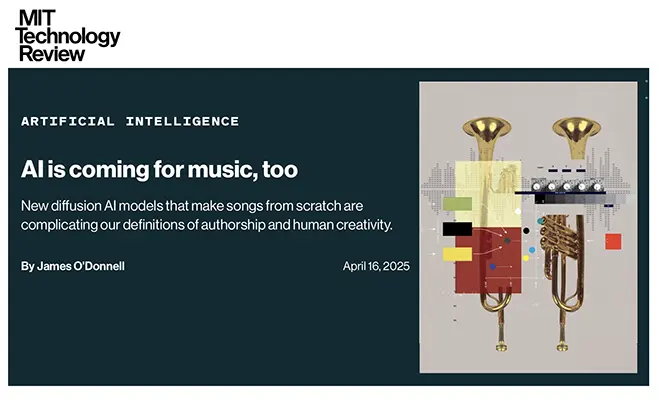
AI Is Coming for Music, Too — MIT Technology Review (Apr 16, 2025)
New diffusion AI models are generating songs from scratch, producing works that can rival human composition in emotional impact. This raises profound questions about authorship, originality, and copyright. Lawsuits from major record labels argue these systems replicate human art without fair compensation, while AI developers frame their tools as creative assistants. The coming battles over music mirror wider struggles over AI’s place in creative industries.
Relevance for Business:
For SMBs in media, entertainment, or marketing, AI music could lower content costs but create copyright and authenticity challenges.
Calls to Action:
🔹 Evaluate licensing risks before using AI-generated music.
🔹 Consider how AI creativity affects branding and originality.
🔹 Monitor legal precedents in AI vs. copyright disputes.
Summary Created by ReadAboutAI.com
https://www.technologyreview.com/2025/04/16/1114433/ai-artificial-intelligence-music-diffusion-creativity-songs-writer: Mid-Week Post September 26, 2025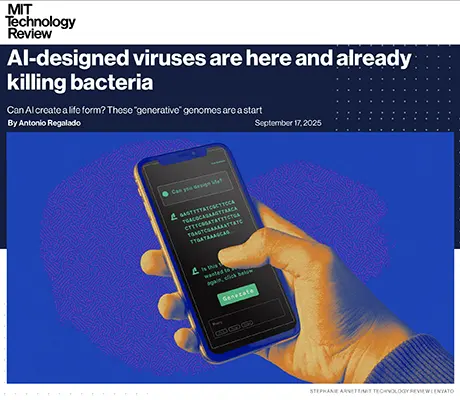
AI-Designed Viruses Are Here and Already Killing Bacteria — MIT Technology Review (Sept 17, 2025)
Summary:
Researchers at Stanford and the Arc Institute used AI to design novel bacteriophage genomes, creating viruses that successfully killed bacteria. Sixteen out of 302 AI-designed viruses replicated and worked, representing the first generative design of complete genomes. While viruses aren’t technically alive, this milestone signals the potential for AI to create engineered biological entities, accelerating new treatments but also surfacing concerns about biosafety and dual-use risks.
Relevance for Business:
Biotech firms and SMB healthcare players should note the potential disruption in antibiotics and biotech R&D. At the same time, executives in other industries must track how AI-biology convergence could bring both opportunity and regulatory scrutiny.
Calls to Action:
🔹 Stay updated on AI-biology breakthroughs that could affect healthcare markets.
🔹 Include biosecurity considerations in risk planning.
🔹 Evaluate long-term opportunities in synthetic biology partnerships.
Summary Created by ReadAboutAI.com
https://www.technologyreview.com/2025/09/17/1123801/ai-virus-bacteriophage-life/: Mid-Week Post September 26, 2025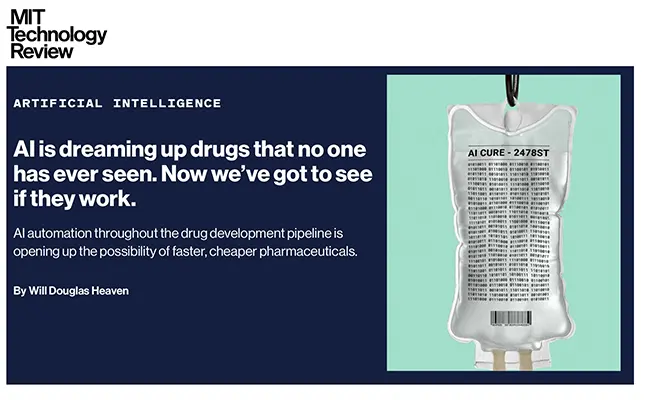
AI Is Dreaming Up Drugs That No One Has Ever Seen. Now We’ve Got to See If They Work. — MIT Technology Review (Feb 15, 2023)
Summary:
AI is revolutionizing drug discovery by automating compound design, testing, and patient-drug matching. Companies like Exscientia are using AI to pair patients with customized treatments and design entirely new molecules. Clinical trials are already underway for AI-generated drugs, reducing the typical 10+ year development timeline and costs. However, experts warn that while AI accelerates drug R&D, lab testing and human trials remain essential.
Relevance for Business:
Healthcare and biotech SMBs can leverage AI to shorten product cycles and lower R&D costs, while adjacent industries (insurance, HR, wellness) should prepare for faster drug availability impacting workforce health.
Calls to Action:
🔹 Assess partnerships with AI pharma startups.
🔹 Monitor how AI drug development could reshape healthcare insurance.
🔹 Explore ethical/legal frameworks around AI-designed treatments.
Summary Created by ReadAboutAI.com
https://www.technologyreview.com/2023/02/15/1067904/ai-automation-drug-development/: Mid-Week Post September 26, 2025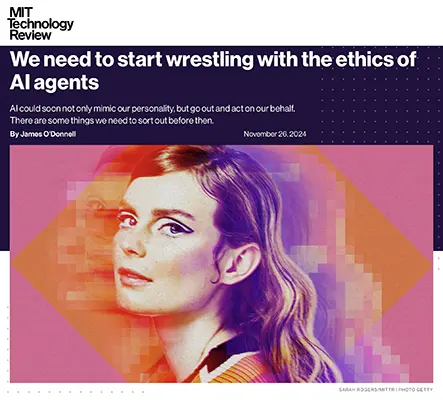
We Need to Start Wrestling with the Ethics of AI Agents — MIT Technology Review (Nov 26, 2024)
Summary:
AI agents are evolving beyond generating content to acting on behalf of humans, either as tool-based agents that complete digital tasks (like form-filling) or as simulation agents that mimic human personalities. Recent Stanford research showed that AI could replicate participants’ values and preferences with striking accuracy, raising the likelihood of digital twins that can impersonate real people. While these advances promise productivity gains, they also surface profound ethical dilemmas: misuse in deepfakes, blurred lines between humans and machines, and whether people deserve to know when they’re interacting with AI.
Relevance for Business:
Executives must prepare for an era where AI agents act autonomously on behalf of staff or customers. This technology will streamline workflows but also create trust and liability risks if not carefully governed.
Calls to Action:
🔹 Audit use cases where AI agents could replace or augment staff.
🔹 Establish policies for disclosure and consent when agents interact with clients.
🔹 Explore legal and HR implications of digital twins and personality replication.
Summary Created by ReadAboutAI.com
https://www.technologyreview.com/2024/11/26/1107309/we-need-to-start-wrestling-with-the-ethics-of-ai-agents/: Mid-Week Post September 26, 2025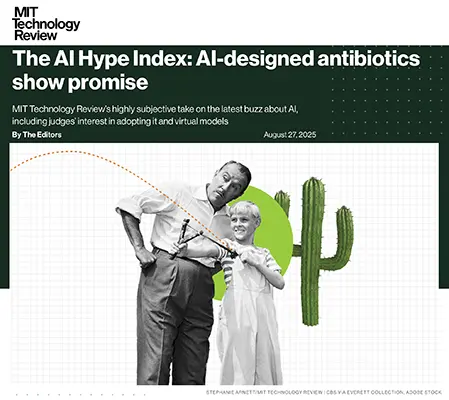
The AI Hype Index: AI-Designed Antibiotics Show Promise — MIT Technology Review (Aug 27, 2025)
The latest AI Hype Index highlights genuine breakthroughs and risks. On the positive side, AI is being used to design new antibiotics for drug-resistant infections, showing early promise. At the same time, missteps such as unsafe medical recommendations from chatbots remind us of the dangers of overreliance. The index reflects the need to separate real progress from hype in an era of fast-moving AI news.
Relevance for Business:
SMBs in healthcare, biotech, or wellness should watch AI-driven drug discovery as a major frontier, but also recognize liability risks tied to premature reliance on AI-generated health advice.
Calls to Action:
🔹 Distinguish between true breakthroughs and marketing hype.
🔹 Build verification layers before acting on AI recommendations.
🔹 Explore partnerships in AI-driven R&D, especially in health.
Summary Created by ReadAboutAI.com
https://www.technologyreview.com/2025/08/27/1122356/the-ai-hype-index-ai-designed-antibiotics-show-promise/: Mid-Week Post September 26, 2025 https://www.technologyreview.com/2024/10/23/1105192/ai-hype-index-nov-dec-2024/: Mid-Week Post September 26, 2025 https://www.technologyreview.com/2025/07/30/1120783/the-ai-hype-index-the-white-houses-war-on-woke-ai/: Mid-Week Post September 26, 2025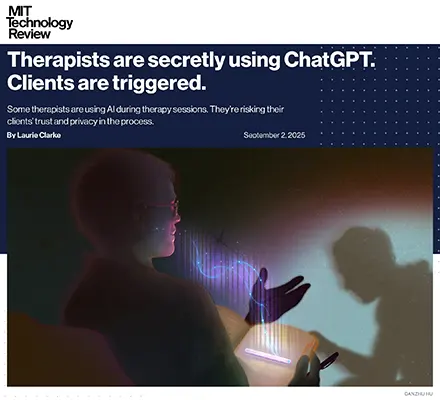
Therapists Are Secretly Using ChatGPT — MIT Technology Review (Sept 2, 2025)
Some therapists have been caught using ChatGPT during client sessions without disclosure, raising serious issues of trust, privacy, and authenticity. While studies show AI-generated responses can match or even exceed therapeutic best practices, clients feel betrayed when they suspect or discover their therapist relied on AI. This reflects a broader challenge: AI can enhance professional communication but risks undermining sensitive human relationships if used without transparency.
Relevance for Business:
Trust is a core driver of customer loyalty. Just as patients feel misled, clients in healthcare, law, or consulting could lose confidence if AI is hidden behind the scenes. SMB leaders must balance efficiency with transparency when deploying AI in client-facing work.
Calls to Action:
🔹 Establish AI-use disclosure policies in sensitive roles.
🔹 Train teams to use AI with oversight, not as a silent replacement.
🔹 Review client-facing workflows for points of trust risk.
Summary Created by ReadAboutAI.com
https://www.technologyreview.com/2025/09/02/1122871/therapists-using-chatgpt-secretly/: Mid-Week Post September 26, 2025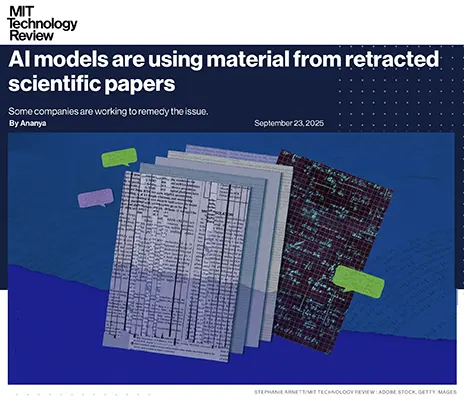
AI Models Are Using Material from Retracted Scientific Papers — MIT Technology Review (Sept 23, 2025)
Summary:
Studies reveal that AI chatbots and research tools sometimes cite retracted scientific papers, presenting flawed information as valid. In tests with retracted medical imaging studies, ChatGPT-4o and others referenced discredited research without warnings. The problem extends to science-focused AI tools like Elicit and Perplexity, which also surfaced unreliable data. This raises serious concerns about the trustworthiness of AI in scientific and medical domains, especially as governments and researchers invest in AI for scientific discovery.
Relevance for Business:
SMB leaders using AI for healthcare, R&D, or compliance-heavy sectors must recognize that AI outputs may be based on discredited sources. Blind trust in AI citations could expose businesses to reputational, legal, or regulatory risks.
Calls to Action:
🔹 Implement fact-checking protocols for AI-generated insights.
🔹 Train staff to recognize risks in AI-cited research.
🔹 Partner with vendors offering source verification tools.
Summary Created by ReadAboutAI.com
https://www.technologyreview.com/2025/09/23/1123897/ai-models-are-using-material-from-retracted-scientific-papers: Mid-Week Post September 26, 2025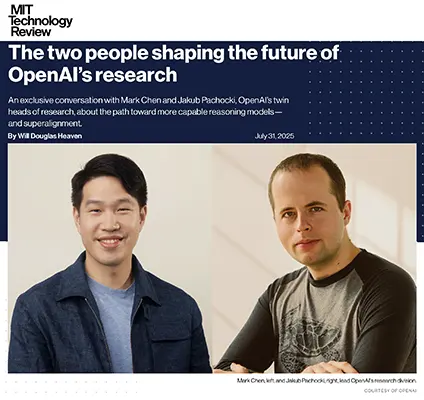
The Two People Shaping the Future of OpenAI’s Research — MIT Technology Review (July 31, 2025)
OpenAI’s research leadership, Mark Chen and Jakub Pachocki, are steering the company toward reasoning-heavy AI models and a focus on superalignment—ensuring advanced AI remains controllable. Their work highlights OpenAI’s dual mission: advancing capabilities while embedding safety guardrails. Their influence will shape not only technical breakthroughs but also industry standards for risk management .
Relevance for Business:
For SMB executives, leadership moves at top labs signal where the industry is heading. The pivot toward reasoning models means more reliable AI assistants but also rising infrastructure demands.
Calls to Action:
🔹 Expect next-gen AI tools with deeper reasoning abilities.
🔹 Track how alignment research shapes regulations and adoption.
🔹 Factor in compute costs as reasoning models expand.
Summary Created by ReadAboutAI.com
https://www.technologyreview.com/2025/07/31/1120885/the-two-people-shaping-the-future-of-openais-research/: Mid-Week Post September 26, 2025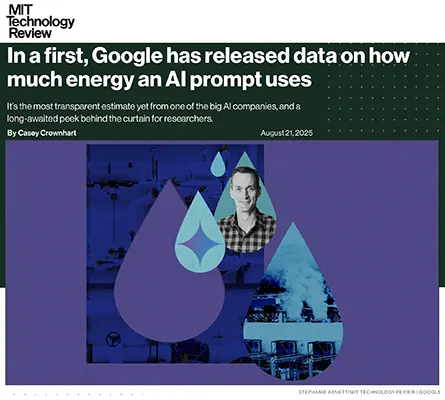
Google Reveals Energy Use of AI Prompts — MIT Technology Review (Aug 21, 2025)
For the first time, Google disclosed the per-prompt energy use of its Gemini AI apps: a median of 0.24 watt-hours per query, roughly equivalent to a second of microwave use. The report details how power is split across TPUs, supporting CPUs, and data center cooling. While modest per prompt, the sheer volume of AI usage scales into major energy costs. This marks a significant step toward transparency in AI sustainability.
Relevance for Business:
Executives should prepare for sustainability reporting demands tied to AI usage. SMBs adopting AI at scale will need to balance efficiency with ESG commitments.
Calls to Action:
🔹 Track AI energy costs in ESG reporting.
🔹 Ask vendors for transparency on energy and emissions.
🔹 Explore green AI practices and energy offsets.
Summary Created by ReadAboutAI.com
https://www.technologyreview.com/2025/08/21/1122288/google-gemini-ai-energy/: Mid-Week Post September 26, 2025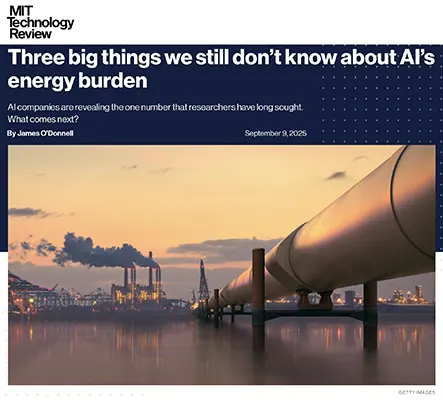
Three Big Unknowns About AI’s Energy Burden — MIT Technology Review (Sept 9, 2025)
Even with Google, OpenAI, and Mistral publishing figures, major gaps remain in understanding AI’s true energy footprint. Current disclosures only cover chat queries, not energy-intensive tasks like video, image generation, or reasoning models. Experts argue that AI’s growing role in data centers requires far more scrutiny, especially as projections show AI could consume up to 22% of U.S. household electricity in three years.
Relevance for Business:
SMBs must anticipate rising infrastructure and sustainability pressures tied to AI adoption. Energy transparency will likely drive new regulations and customer expectations.
Calls to Action:
🔹 Plan for higher AI-related energy costs in operations.
🔹 Stay informed on emerging energy reporting standards.
🔹 Push vendors for full-lifecycle energy data beyond chatbots.
Summary Created by ReadAboutAI.com
https://www.technologyreview.com/2025/09/09/1123408/three-big-things-we-still-dont-know-about-ais-energy-burden/: Mid-Week Post September 26, 2025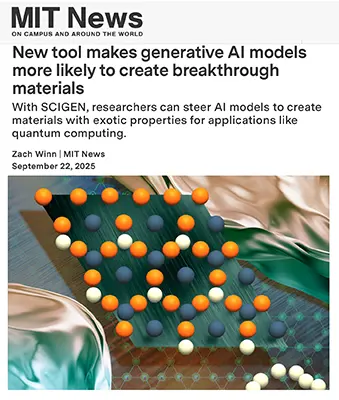
New Tool Makes Generative AI Models More Likely to Create Breakthrough Materials — MIT News (Sept 22, 2025)
Summary:
MIT researchers introduced SCIGEN, a tool that helps AI models generate quantum materials with exotic properties, such as superconductivity. By imposing structural constraints, SCIGEN directs diffusion models to design materials with rare lattice structures, accelerating discovery in quantum computing and carbon capture. Early results yielded two new compounds with magnetic traits, highlighting how AI-guided material science could compress decades of trial-and-error into months.
Relevance for Business:
For industries in electronics, energy, and advanced materials, AI is poised to reshape R&D pipelines. Businesses that monitor or partner in these developments could leap ahead in innovation capacity and reduce dependency on scarce resources.
Calls to Action:
🔹 Track advances in AI-driven materials science for future supply chain shifts.
🔹 Explore collaborations with research institutions using SCIGEN-like tools.
🔹 Consider implications for quantum-enabled technologies in planning.
Summary Created by ReadAboutAI.com
https://news.mit.edu/2025/new-tool-makes-generative-ai-models-likely-create-breakthrough-materials-0922: Mid-Week Post September 26, 2025Mid-week roundup of MIT Research articles
Conclusion:
This mid-week special signals that AI is moving faster than the weekly news cycle, and ReadAboutAI.com will continue to expand coverage to keep SMB leaders informed, prepared, and ahead of the curve.
Summary Created by ReadAboutAI.com

Tech Target September AI Articles
Introduction
The mid-week AI developments highlight the accelerating pace of innovation, investment, and integration across the global AI ecosystem. From Alibaba’s deepened partnership with Nvidia to Workday’s expansion of AI agents, companies are embedding AI into every layer of business infrastructure. Meanwhile, Google Cloud’s startup-driven boom, Microsoft’s Fabric upgrades, and Box’s enhanced document intelligence underscore how cloud and SaaS platforms are racing to provide AI-ready environments. At the same time, key debates around SEO’s evolution and sustainability challenges remind us that executives must balance opportunity with risk.
https://www.techtarget.com: Mid-Week Post September 26, 2025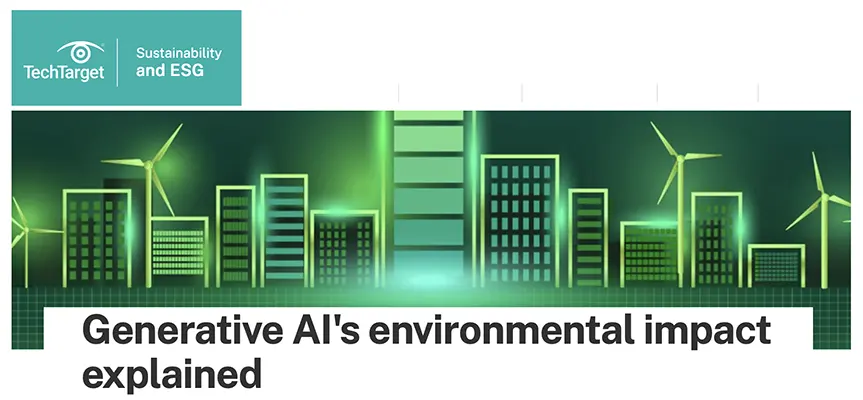
Generative AI’s Environmental Impact (TechTarget, Sept 17, 2025)
Summary
Generative AI carries a high carbon footprint, requiring significant energy, water, and compute resources. Its growth drives more data center construction and contributes to e-waste. While GenAI boosts global GDP potential, it poses escalating sustainability challenges.
Relevance for Business
Executives must prepare for regulatory and reputational risks as green compliance standards tighten. Sustainability now intersects directly with AI adoption strategies.
Calls to Action
🔹 Audit AI vendors for sustainability commitments.
🔹 Weigh the environmental cost of large-scale AI tools.
🔹 Explore “efficient LLMs” and carbon-neutral compute options.
Summary Created by ReadAboutAI.com
https://www.techtarget.com/sustainability/feature/Generative-AIs-sustainability-problems-explained: Mid-Week Post September 26, 2025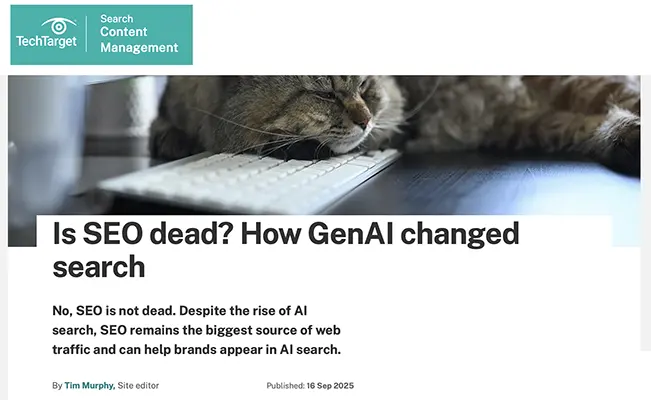
Is SEO Dead? GenAI’s Impact on Search (TechTarget, Sept 16, 2025)
Summary
Generative AI platforms like ChatGPT and Perplexity are reshaping how users find information, with Gartner predicting a 25% drop in web traffic by 2026. While some call SEO obsolete, experts argue it is transforming: brands must now optimize for both traditional search engines and AI-driven query tools.
Relevance for Business
For SMBs reliant on organic traffic, this marks a turning point. Success means adapting strategies for Generative Engine Optimization (GEO) and AI-discovery platforms.
Calls to Action
🔹 Rework SEO strategies to account for GenAI-driven search.
🔹 Optimize content for conversational AI platforms.
🔹 Track analytics to see if traffic shifts from Google to AI bots.
Summary Created by ReadAboutAI.com
https://www.techtarget.com/searchcontentmanagement/feature/Is-SEO-dead-How-GenAI-changed-search: Mid-Week Post September 26, 2025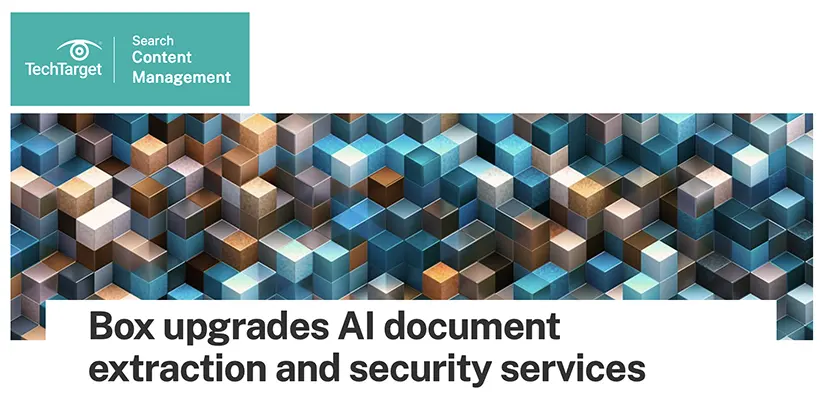
Box Upgrades AI Document Extraction & Security (TechTarget, Sept 11, 2025)
Summary
Box is rolling out three AI agents for document extraction, classification, and security. “Box Extract” extends metadata tagging to recognize contracts, spreadsheets, and scanned images, while also securing sensitive files. The tools leverage agentic AI and Box’s acquisition of Alphamoon for intelligent document processing (IDP).
Relevance for Business
For SMBs managing growing digital archives, Box’s new features reduce compliance risk, improve data governance, and enhance search efficiency.
Calls to Action
🔹 Evaluate IDP tools to cut time spent on manual document review.
🔹 Strengthen compliance processes with automated classification.
🔹 Compare Box’s offering with Microsoft, Google, and Dropbox AI upgrades.
Summary Created by ReadAboutAI.com
https://www.techtarget.com/searchcontentmanagement/news/366630632/Box-upgrades-AI-document-extraction-and-security-services: Mid-Week Post September 26, 2025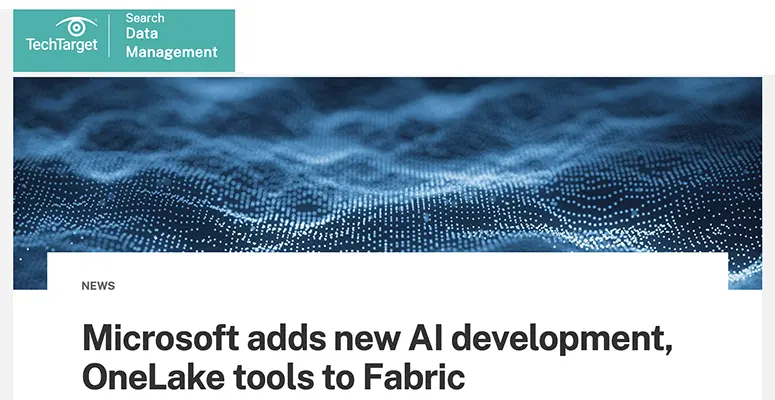
Microsoft Adds AI Tools to Fabric (TechTarget, Sept 16, 2025)
Summary
Microsoft announced new features in its Fabric platform, including Model Context Protocol (MCP) support, access to Oracle and Google Cloud data, and geospatial graph database tools. These updates aim to unify seven data workloadsand simplify building AI-driven applications.
Relevance for Business
Fabric represents Microsoft’s push to create a one-stop data hub. For SMBs, it lowers integration costs and makes it easier to scale analytics and AI applications.
Calls to Action
🔹 Evaluate Fabric for consolidating scattered data sources.
🔹 Explore MCP adoption to ensure vendor compatibility.
🔹 Leverage geospatial and graph capabilities for deeper insights.
Summary Created by ReadAboutAI.com
https://www.techtarget.com/searchdatamanagement/news/366631393/Microsoft-adds-new-AI-development-OneLake-tools-to-Fabric: Mid-Week Post September 26, 2025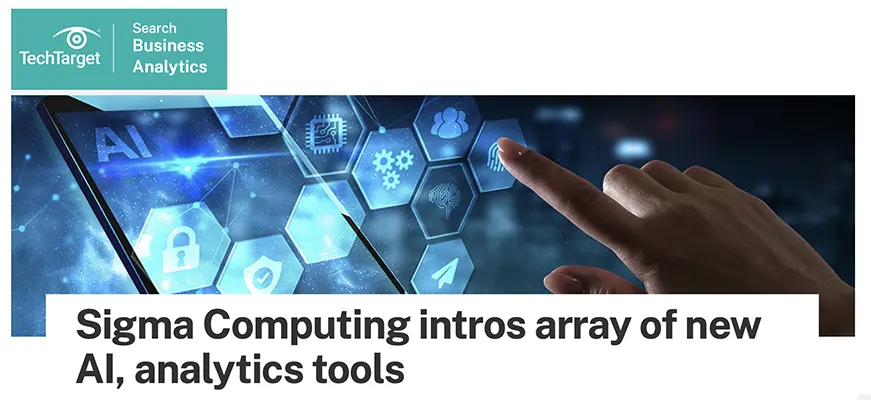
Sigma Computing Introduces New AI Analytics Tools (TechTarget, Sept 11, 2025)
Summary
Sigma Computing unveiled new natural language tools, support for the Model Context Protocol (MCP), and upgrades to “Ask Sigma” that let non-technical employees extract insights and even build apps. These features aim to democratize data analysis across enterprises.
Relevance for Business
SMBs gain access to self-service analytics, reducing reliance on IT teams and enabling faster decisions.
Calls to Action
🔹 Pilot natural language analytics to empower non-technical staff.
🔹 Assess if MCP-based integrations can unify multiple data sources.
🔹 Train teams to explore AI-enabled business intelligence tools.
Summary Created by ReadAboutAI.com
https://www.techtarget.com/searchbusinessanalytics/news/366630504/Sigma-Computing-intros-array-of-new-AI-analytics-tools: Mid-Week Post September 26, 2025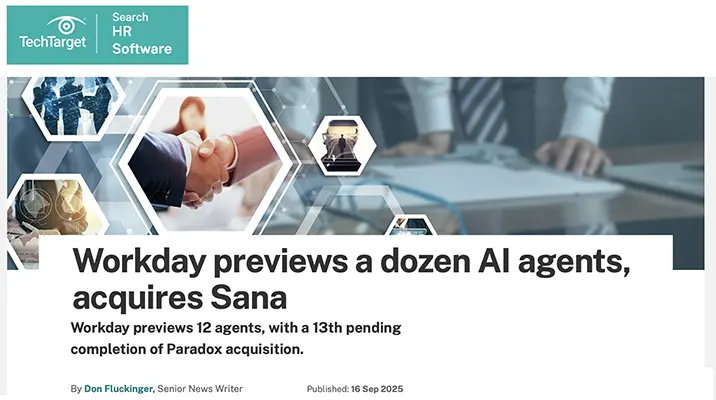
Workday Previews 12 AI Agents, Acquires Sana (TechTarget, Sept 16, 2025)
Summary
Workday introduced a dozen new AI agents for HR and finance, plus developer tools for custom agents. It also announced a $1.1B acquisition of Sana, an AI-driven learning and content platform, and is finalizing a deal for Paradox, a recruiting agent builder. This follows earlier purchases like Flowise.
Relevance for Business
Workday is embedding AI deeply into HR and financial workflows, making AI agents central to talent managementand automation of routine tasks.
Calls to Action
🔹 If using Workday, explore how new agents can reduce admin workload.
🔹 Track how acquisitions reshape the HR tech landscape.
🔹 Prepare teams for AI-driven changes in recruiting and learning.
Summary Created by ReadAboutAI.com
https://www.techtarget.com/searchhrsoftware/news/366631340/Workday-previews-a-dozen-AI-agents-acquires-Sana: Mid-Week Post September 26, 2025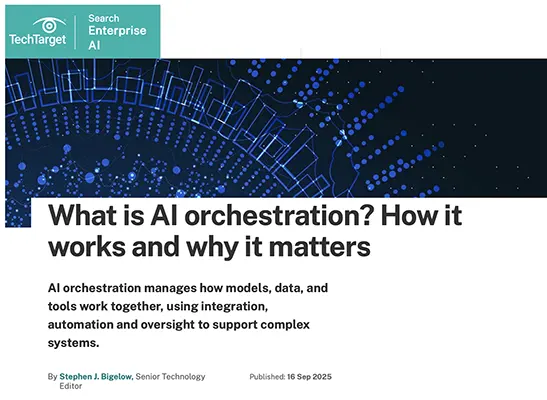
What is AI Orchestration? (TechTarget, Sept 16, 2025)
Summary
AI orchestration refers to managing how models, data, and tools work together in a seamless system. It involves integration, automation, and oversight across machine learning models, production and training data, and infrastructure. The goal is to harmonize disparate AI elements to achieve clear business objectives.
Relevance for Business
For SMBs, orchestration is the “glue” of AI systems—critical when layering multiple vendors or tools. Without orchestration, AI projects risk fragmentation, inefficiency, and higher costs.
Calls to Action
🔹 Map your AI workflows to see where orchestration could reduce silos.
🔹 Ensure vendors support orchestration standards for future interoperability.
🔹 Start small—pilot orchestration in one department before scaling.
Summary Created by ReadAboutAI.com
https://www.techtarget.com/searchenterpriseai/tip/What-is-AI-orchestration-How-it-works-and-why-it-matters: Mid-Week Post September 26, 2025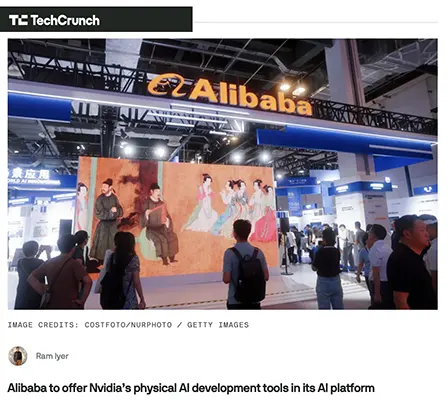
Alibaba to Offer Nvidia’s Physical AI Tools (TechCrunch, Sept 24, 2025)
Summary
Alibaba announced it will integrate Nvidia’s Physical AI development tools into its AI Cloud Platform, strengthening China’s access to advanced AI hardware and simulation capabilities. These tools power robotics, self-driving cars, and connected environments, enabling the creation of 3D replicas of real-world spaces. This move follows Nvidia’s $5B stake in Intel and a record $100B commitment to OpenAI, signaling its aggressive expansion across global markets.
Relevance for Business
For SMB executives, this underscores the rapid globalization of AI infrastructure. Even non-Chinese firms will feel the ripple effects as global supply chains, partnership opportunities, and competitive AI ecosystems expand.
Calls to Action
🔹 Track cross-border AI alliances, as they may affect vendor pricing and availability.
🔹 Consider how simulation tools (digital twins, robotics training) could apply to your industry.
🔹 Watch for competitive shifts if Alibaba Cloud expands internationally with Nvidia backing.
Summary Created by ReadAboutAI.com
https://techcrunch.com/2025/09/24/alibaba-to-offer-nvidias-physical-ai-development-tools-in-its-ai-platform/: Mid-Week Post September 26, 2025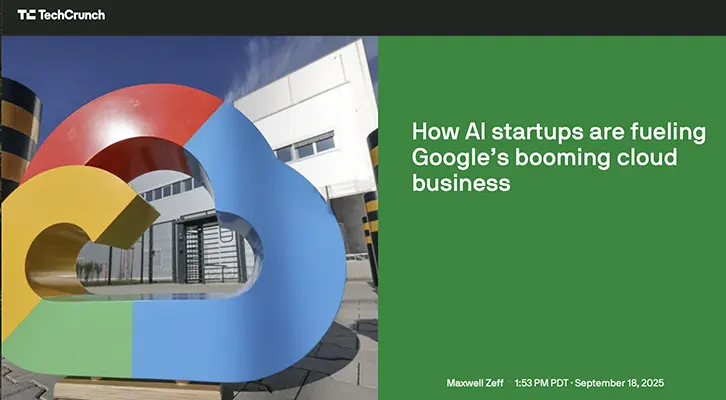
AI Startups Fuel Google’s Cloud Boom (TechCrunch, Sept 2025)
Summary
Google Cloud is seeing explosive growth thanks to AI startups choosing it as their platform. Startups cite Google’s TPUs, Vertex AI, and competitive pricing as key advantages. The AI surge has made Google Cloud a central player in AI infrastructure, rivaling AWS and Azure.
Relevance for Business
SMBs can expect greater competition for cloud resources, but also more AI-ready cloud services tailored for speed and experimentation.
Calls to Action
🔹 Evaluate Google Cloud’s AI-native services for your next project.
🔹 Compare multi-cloud options for cost and resilience.
🔹 Watch for startup-driven innovation that may create new partnership opportunities.
Summary Created by ReadAboutAI.com
https://techcrunch.com/2025/09/18/how-ai-startups-are-fueling-googles-booming-cloud-business/: Mid-Week Post September 26, 2025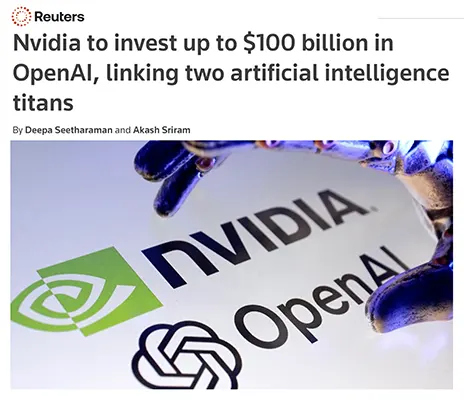
Nvidia to Invest $100B in OpenAI (Reuters, Sept 23, 2025)
Summary
Nvidia will invest up to $100 billion in OpenAI, acquiring non-voting shares and supplying data center chips. This deepens the partnership between two AI titans and may attract antitrust scrutiny given Nvidia’s dominance in GPU supply. The deal highlights the consolidation of power among top AI players.
Relevance for Business
For SMBs, this signals both accelerated AI innovation and potential supply chain risk if Nvidia prioritizes OpenAI’s massive needs.
Calls to Action
🔹 Diversify compute vendor options to avoid dependency on Nvidia.
🔹 Monitor regulatory responses that could shift industry dynamics.
🔹 Anticipate downstream pricing impacts in cloud and AI services.
Summary Created by ReadAboutAI.com
https://www.reuters.com/business/nvidia-invest-100-billion-openai-2025-09-22/: Mid-Week Post September 26, 2025Conclusion: Special Mid-week update September 26, 2025
📌 Conclusion
Taken together, these stories show a market defined by mega-investments, rapid platform upgrades, and shifting competitive dynamics. For SMB executives, the message is clear: AI is no longer an optional experiment but an essential strategic layer. The challenge now is to choose wisely—balancing cost, compliance, and sustainability—while preparing teams for an AI-driven operating environment that is reshaping both global giants and local businesses.
↑ Back to Top
